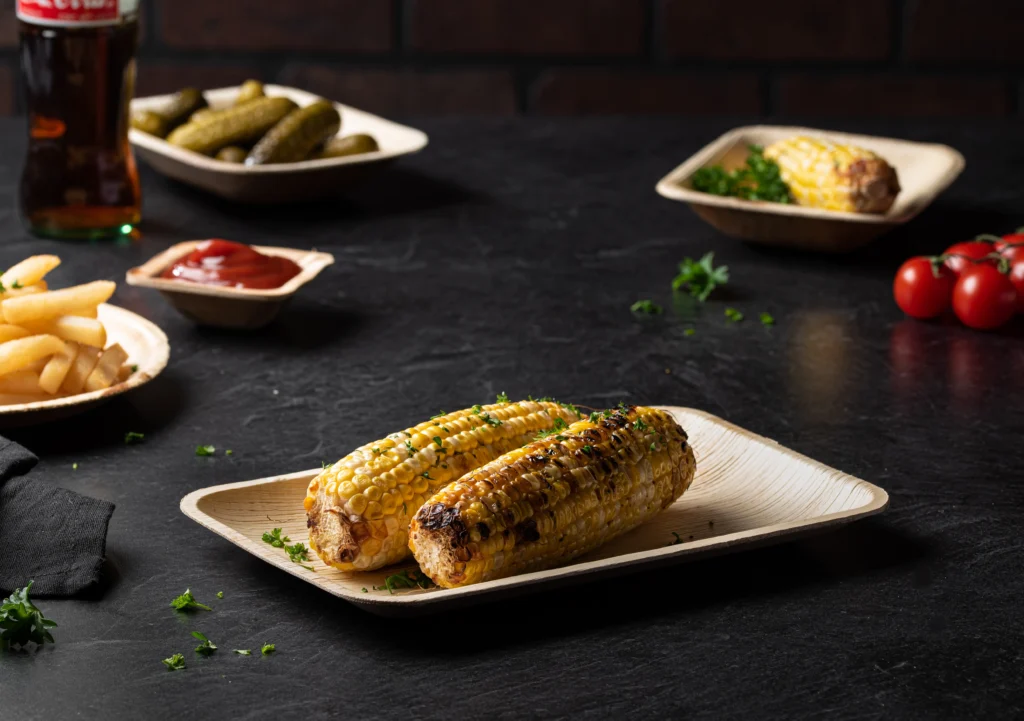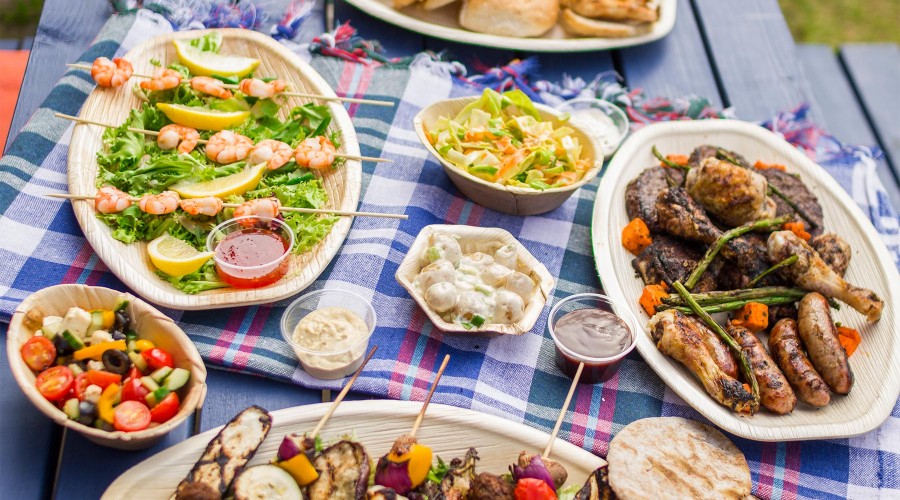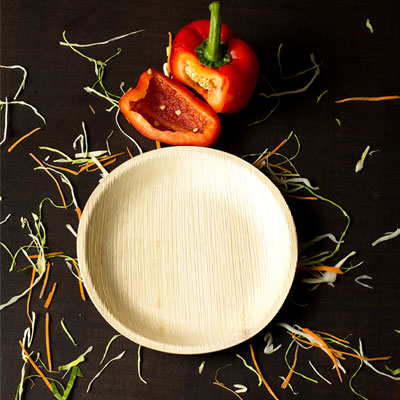Discover the top reasons why Palm Leaf Plates are the ultimate choice for eco-conscious consumers. From their biodegradability and aesthetic appeal to their durability and support for local economies, learn how these sustainable tableware options can transform your dining experience while protecting the planet.
Introduction to Palm Leaf Plates
In a world increasingly conscious of environmental sustainability, palm leaf plates emerge as a compelling choice for eco-friendly and stylish tableware. But what exactly are these plates, and why are they gaining popularity?
Table of Contents
What Are Palm Leaf Plates?
Palm leaf plates are an eco-friendly alternative to traditional disposable tableware, made from the fallen leaves of the Areca palm tree, which is found in tropical regions of the world. These plates are created using a simple yet innovative process that harnesses natural resources without causing harm to the environment. Unlike conventional paper or plastic plates, palm leaf plates do not require the cutting down of trees or extensive manufacturing processes involving harmful chemicals and pollutants.
The process of making palm leaf plates is both sustainable and straightforward. Once the Areca leaves have naturally fallen from the trees, they are collected, cleaned, and then subjected to a heat-pressing process. This process molds the leaves into various shapes and sizes suitable for different dining needs, from plates and bowls to trays. The heat also sterilizes the leaves, ensuring they are safe for serving food. No additional chemicals or synthetic materials are added, maintaining the natural composition of the plates.
One of the most distinctive features of palm leaf plates is their unique appearance. Each plate has its own patterns, textures, and color variations, reflecting the natural origin of the material. This adds an aesthetic appeal that is often lacking in standard disposable tableware, making palm leaf plates a popular choice for events, weddings, and any occasion looking to add a touch of natural elegance to the dining experience.
Palm leaf plates are completely biodegradable and compostable, decomposing in a matter of months when disposed of properly. This makes them an excellent choice for those looking to minimize their environmental impact. They offer a practical solution for reducing waste and avoiding the pollution associated with plastic disposables.
The Sustainability of Palm Leaf Plates
Origin and Production
Palm leaf plates are made from the fallen leaves of the Areca palm tree, which naturally shed their leaves as part of their growth cycle. This means that the raw material for these plates is sourced without harming the trees or requiring additional agricultural inputs like water, fertilizers, or pesticides. The process of collecting fallen leaves also helps in cleaning the plantation floor, reducing fire hazards and promoting healthier growth conditions for the trees.
The production process of palm leaf plates is simple and energy-efficient. It involves cleaning, heat-pressing, and trimming the leaves into desired shapes and sizes. This process does not emit harmful pollutants or require significant energy inputs, especially when compared to the manufacturing processes for plastic or paper tableware. Additionally, since no chemicals or synthetic materials are added, palm leaf plates are a pure, natural product.
Biodegradability and Compostability
After use, palm leaf plates can be composted, returning to the earth without leaving harmful residues. They break down naturally within a few months in a composting system, transforming into nutrient-rich soil that can support plant growth. This contrasts sharply with plastic disposables, which can take hundreds of years to decompose and often break down into microplastics that pollute soil and waterways.
Reduction of Waste and Pollution
By choosing palm leaf plates, consumers can significantly reduce the amount of waste and pollution generated by their dining habits. Since these plates are biodegradable and compostable, they do not contribute to landfill overflow or the leaching of toxic chemicals into the environment. This reduction in waste and pollution is crucial for preserving natural ecosystems and ensuring a healthier planet.
Economic Sustainability
The production of palm leaf plates also supports sustainable economic development in rural areas where Areca palm trees are grown. It provides a source of income for local communities through the collection and processing of fallen leaves. This not only helps to improve the livelihoods of these communities but also promotes sustainable land management practices.

Benefits of Using Palm Leaf Plates
Eco-Friendly and Biodegradable
The most significant benefit of palm leaf plates is their eco-friendliness. Made entirely from fallen leaves of the Areca palm, these plates are 100% natural and biodegradable. Unlike plastic or synthetic disposables that linger in landfills for centuries, palm leaf plates decompose naturally, turning back into soil without harming the environment. This biodegradability ensures a minimal ecological footprint, making palm leaf plates a superior choice for eco-conscious consumers and events.
Durability and Usability
Despite their natural composition, palm leaf plates are remarkably durable and robust. They can comfortably hold hot, cold, wet, and oily foods without leaking or becoming soggy, a common issue with paper-based disposables. This makes them an excellent option for a wide range of culinary applications, from outdoor barbecues to elegant wedding receptions. Their strength and usability ensure that guests can enjoy their meals without the inconvenience of flimsy tableware.
Aesthetic Appeal
Palm leaf plates have a unique, rustic charm that enhances the dining experience. Each plate features a distinct pattern and texture, reflecting the natural beauty of the palm leaf from which it was made. This aesthetic appeal makes palm leaf plates a popular choice for those looking to add an elegant, earthy touch to their table settings. Whether it’s a casual gathering or a formal event, palm leaf plates can elevate the presentation of any meal.
Versatility in Use
The versatility of palm leaf plates is another compelling benefit. They are suitable for a variety of settings, from casual picnics to formal dinners, and can be used to serve an array of dishes. Additionally, their natural, neutral design complements any decor or theme, making them a flexible choice for all types of events and occasions.
Health Benefits
Palm leaf plates are free from chemicals, toxins, and synthetic materials, making them a healthier alternative to plastic disposables that can leach harmful substances into food. By choosing palm leaf plates, consumers can reduce their exposure to these contaminants, ensuring a safer dining experience.
Supporting Local Economies
The production of palm leaf plates provides economic opportunities for rural communities where Areca palms are grown. Collecting fallen leaves and manufacturing plates can offer a sustainable source of income for these areas, contributing to local economies and promoting social sustainability.
Waste Reduction
Adopting palm leaf plates contributes to waste reduction efforts. Since they are biodegradable and compostable, they significantly reduce the amount of waste sent to landfills compared to conventional disposable tableware. This aligns with broader waste management and reduction strategies essential for environmental sustainability.

How Palm Leaf Plates Are Made
1. Collection of Fallen Leaves
The first step in the production of palm leaf plates involves collecting fallen Areca palm leaves. These leaves are gathered from the ground in palm groves, ensuring that no trees are harmed or cut down during the process. This method of sourcing materials is sustainable and environmentally friendly, as it utilizes natural waste without disturbing the ecosystem.
2. Cleaning and Sanitizing
Once collected, the leaves are thoroughly cleaned to remove any dirt and debris. This is typically done using water and, occasionally, a natural, mild disinfectant. The cleaning process ensures that the leaves are hygienic and suitable for further processing into plates.
3. Drying
After cleaning, the leaves are left to dry. This can be done naturally under the sun or in a controlled environment using low-energy drying methods. Proper drying is crucial to prepare the leaves for the heat-pressing process, ensuring they are free from moisture that could affect the quality of the final product.
4. Heat-Pressing
The dried leaves are then placed in a heat-press machine, which molds them into the desired shapes and sizes. The heat and pressure applied during this process sterilize the leaves, making them safe for food contact. This step does not involve any chemicals or additives, maintaining the natural purity of the plates. The heat-pressing also enhances the durability and rigidity of the plates, allowing them to hold food effectively.
5. Trimming and Finishing
After the leaves have been pressed into plates, any excess material is trimmed to ensure clean edges and uniformity in size. This step gives the plates their final appearance and makes them ready for packaging and distribution. The trimming process is generally done manually, which allows for careful quality control and the preservation of jobs in the manufacturing communities.
6. Packaging
The finished palm leaf plates are then packaged, often in eco-friendly materials, and prepared for distribution. Packaging is designed to protect the plates during transport while minimizing the environmental impact.
Comparing Palm Leaf Plates with Other Disposable Options
Palm Leaf vs. Plastic Plates
Environmental Impact: Plastic plates are made from petroleum-based polymers and can take hundreds of years to decompose. They contribute significantly to pollution and can release toxic chemicals as they break down, harming wildlife and ecosystems. In contrast, palm leaf plates are completely biodegradable and compostable, decomposing naturally within a few months without releasing harmful substances.
Health and Safety: Plastic plates can leach chemicals, especially when used with hot foods. Palm leaf plates, being natural and chemical-free, do not pose such health risks, making them a safer option for serving food.
Aesthetics and Experience: Plastic plates often have a generic look and can feel flimsy, detracting from the dining experience. Palm leaf plates, with their unique textures and patterns, offer a more elegant and sturdy alternative, enhancing the visual appeal of meals.
Palm Leaf vs. Paper Plates
Environmental Impact: While paper plates are derived from a renewable resource, their production involves cutting down trees, contributing to deforestation. Additionally, the manufacturing process of paper plates can be water and energy-intensive. Palm leaf plates, on the other hand, use fallen leaves that would otherwise go to waste, requiring much less energy and no tree cutting, making them a more sustainable option.
Durability: Paper plates can become soggy with wet or oily foods, leading to leaks and spills. Palm leaf plates are much sturdier and resistant to moisture and oil, making them suitable for a wider range of foods without compromising on functionality.
Compostability: Both paper and palm leaf plates are biodegradable and compostable. However, some paper plates are coated with plastic or wax to improve their moisture resistance, which can complicate the composting process. Palm leaf plates do not require such coatings, ensuring straightforward compostability.
Economic and Social Impact
Cost: Initially, palm leaf plates may seem more expensive than plastic or paper options. However, considering their environmental benefits, aesthetic value, and durability, they offer better long-term value, particularly for those committed to sustainable practices.
Supporting Local Economies: The production of palm leaf plates can provide economic benefits to rural areas where palm trees are abundant, offering a sustainable source of income for local communities. This aspect is less pronounced in the mass production of plastic and paper plates.

The Economic Impact of Choosing Palm Leaf Plates
Supporting Local Communities
Palm leaf plates are typically produced in regions where Areca palm trees are abundant, such as South Asia and parts of Africa. The production process provides a sustainable source of income for rural communities in these areas. By utilizing fallen leaves that would otherwise go unused, manufacturers create a demand for a natural resource that is readily available, thereby supporting the local economy. This can lead to job creation in collection, manufacturing, and distribution processes associated with palm leaf plate production.
Sustainable Development
Investing in palm leaf plates supports sustainable development by promoting practices that are environmentally responsible, economically viable, and socially equitable. By choosing products that do not deplete natural resources, consumers contribute to a market that values sustainability. This, in turn, encourages businesses to invest in eco-friendly technologies and production methods, fostering innovation in green products and services.
Reducing Environmental Costs
The environmental cost of disposable plastic and paper products is high, considering pollution cleanup, landfill maintenance, and the health impacts of pollution on communities. By reducing reliance on such products and choosing biodegradable alternatives like palm leaf plates, the long-term economic burden associated with environmental degradation can be lessened. This includes lower costs for waste management and pollution control, as well as reduced health care costs related to pollution-related illnesses.
Market Influence
Consumer demand for palm leaf plates and other eco-friendly products sends a strong signal to the market, encouraging manufacturers and retailers to prioritize sustainability in their offerings. This can lead to increased competition in the eco-friendly sector, driving down prices and making sustainable products more accessible to a broader audience. Over time, this could shift the overall market towards more sustainable practices, reducing the economic and environmental costs associated with disposable products.
Cost-Effectiveness for Consumers
While palm leaf plates may have a higher upfront cost compared to plastic or paper options, their durability and aesthetic appeal can offer better value in certain settings, such as events and catering services. Additionally, the long-term savings associated with reduced environmental impact and the potential for composting and waste reduction can offset initial expenses, making palm leaf plates a cost-effective choice in the broader context.
Global Economic Benefits
On a global scale, the shift towards sustainable products like palm leaf plates can contribute to economic stability by reducing the strain on natural resources and mitigating the impacts of climate change. This can lead to more stable food prices, reduced risk of resource-related conflicts, and a healthier global economy that is less dependent on finite resources.
How to Incorporate Palm Leaf Plates into Your Lifestyle
For Home Use
- Daily Meals: Start using palm leaf plates for everyday meals to reduce the use of disposable plastic or paper plates. Their natural aesthetic can add a unique touch to your dining experience.
- Special Occasions: Use palm leaf plates for birthdays, anniversaries, or any special gatherings at home. They are a conversation starter and show your commitment to sustainability.
- Kids’ Parties: Children’s parties often involve disposable tableware. Switching to palm leaf plates can teach kids about eco-friendly practices while ensuring a safer, chemical-free option for serving food.
In Social Gatherings
- Barbecues and Picnics: Palm leaf plates are ideal for outdoor events. Their sturdy nature can handle all types of food, and they won’t harm the environment if you’re dining in natural settings.
- Weddings and Large Events: For those planning a wedding or a large gathering, palm leaf plates offer an eco-chic alternative to traditional disposables, aligning with themes of sustainability and natural beauty.
- Community Events: Encourage your local community centers, churches, or schools to use palm leaf plates for their events. It’s a great way to spread awareness about sustainable living.
At Work or School
- Office Parties and Meetings: Recommend palm leaf plates for office gatherings or meetings where snacks or meals are served. This can be part of a broader initiative to make your workplace more eco-friendly.
- School Lunches: For parents packing school lunches, palm leaf plates can be used for special occasions or field trips, providing a teachable moment on sustainability for children.
Advocacy and Awareness
- Gifts: Giving sets of palm leaf plates as gifts can introduce friends and family to sustainable products they might not know about. It’s a thoughtful way to share your values with loved ones.
- Social Media: Share your experiences using palm leaf plates on social media to raise awareness about their benefits and encourage others to make the switch.
Practical Considerations
- Composting: If you have a compost bin, palm leaf plates can be added after use, turning into nutrient-rich compost for your garden.
- Purchasing: Look for palm leaf plates at local eco-friendly stores or online. Buying in bulk can reduce costs and ensure you have them on hand for any occasion.
Sustainability Beyond Tableware
- Holistic Approach: Incorporating palm leaf plates into your lifestyle can be part of a broader commitment to sustainability. Consider other eco-friendly products and practices, like reusable straws, cloth napkins, and minimizing food waste, to enhance your impact.

Conclusion
Choosing palm leaf plates is not just about selecting tableware; it’s about making a conscious decision towards a more sustainable and eco-friendly lifestyle. Their benefits extend far beyond their biodegradability, touching on aspects of health, aesthetics, and even economic impact.
FAQs
- How long do palm leaf plates take to decompose? Palm leaf plates typically decompose within 60 days when composted properly.
- Can palm leaf plates be reused? While they are designed for single use, they can sometimes be gently cleaned and reused for dry foods.
- Are palm leaf plates safe for hot foods? Yes, they are safe for hot foods and do not release any harmful chemicals when in contact with heat.
- Where can I buy palm leaf plates? They are available at many eco-friendly stores, online retailers, and specialty shops.
- Do palm leaf plates contribute to deforestation? No, they are made from fallen leaves, which means they do not require cutting down trees, thereby not contributing to deforestation.
